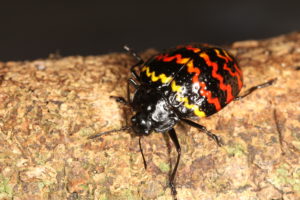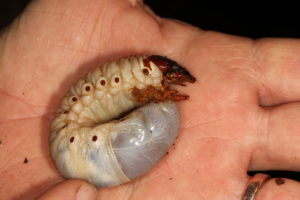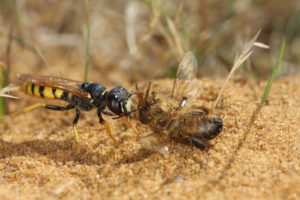Drugs from bugs: the next blockbuster medicine could be lurking inside an insect

For thousands of years humans turned to nature to cure and soothe their ills. Pharmaceutical science built on these ancient foundations and the natural product discovery (NPD) programmes established by pharmaceutical companies provided us with a huge range of medicines derived from nature to treat cancer, microbial infections, hypocholesteraemia and tissue rejection in organ transplantations to name but a few.
Discovering medicines from nature is far from straightforward though. Finding sufficient numbers of the organism in question, isolating and characterising the compound of interest and producing large quantities of said compounds are all significant hurdles (Cragg and Newman, 2013).
With all these stumbling blocks it’s no surprise that pharmaceutical companies shifted the focus of their drug-discovery efforts from nature to the laboratory bench e.g. designing compounds from scratch (combinatorial chemistry), huge numbers of which could then be screened for promising activity using a technique known as high throughput screening (Cragg and Newman, 2013; Dias et al. 2012). From the 1990s onwards the pharmaceutical companies duly terminated their NPD programmes and the huge collections of screening extracts they amassed were sold or disbanded.
Laboratory bench drug discovery has achieved varying levels of success, which has prompted the development of new approaches with a shift back towards natural products. With the ability to mine genomes for useful compounds it is now evident that we have barely scratched the surface of nature’s molecular diversity, which has been honed by more than three billion years of trial and error (Cragg and Newman, 2013). This realisation and several looming health crises, e.g. antibiotic resistance, has put bioprospecting – the search for useful compounds in nature – firmly back on the map.
It is well known that many natural product-derived medicines are sourced from plants and micro-organisms, yet our fellow animals have also provided us with medicines that save and improve millions of lives every year. However, the exploration of animals as a source of novel medicines has been largely restricted to vertebrate venoms, annelid saliva and the venoms and secretions of a few, mostly marine lineages (e.g. sponges, tunicates, molluscs and ectoprocts). The staggering diversity of the animals and their potential as sources of novel pharmaceuticals has barely been explored. Regardless, the tiny sliver of animal diversity investigated thus far has yielded many interesting compounds, some of which have been developed into successful therapeutic products for a range of human diseases, including several types of cancer, cardiovascular disease, type 2 diabetes, autoimmune diseases and chronic severe pain (see Box 1)

Box 1
Captopril, enalapril and eptifibatide are derived from or inspired by compounds found in snake venom and are used routinely to treat hypertension, cardiac failure and acute coronary syndrome (Fox et al. 2007). Exenatide, derived from exendin-4, a peptide hormone from the saliva of the gila monster lizard, is used to treat type 2 diabetes (Hood et al. 2006; McGivern 2007). In 2014, exenatide generated sales of $767 million (Astra Zeneca 2014), of which exactly $0 found their way back to the conservation of the near-threatened gila monster. Bivalirudin and desirudin, derived from hirudin in leech saliva, are used as anti-coagulants (Abdualkader et al. 2013). Ziconotide, an extremely potent pain-killer is derived from a marine snail (Olivera et al. 2007). Investigations of sessile, marine organisms, particularly sponges, tunicates and bryozoans have yielded treatments and promising leads for several types of cancer and autoimmune disease.
Marine animals have always been a favoured target for those interested in novel pharmaceuticals (Martins, et al. 2014), but two-thirds of animal-derived drugs currently on the market are derived from terrestrial or freshwater species. Insects are the undisputed masters of the terrestrial domain, where they occupy every conceivable niche. Consequently, they have a bewildering array of interactions with other organisms, which has driven the evolution of an enormous variety of very interesting compounds for defensive and offensive purposes. Their diversity is also nothing short of dazzling and dwarves every other group of animals on the planet combined. To date, more than one million insect species have been described and there are many millions more out there still to be described. Even though insects are far and away the most diverse animals, their potential as sources of therapeutic compounds is yet to realised. Of the tiny proportion of insects that have been investigated, several interesting compounds have been identified. For example, alloferon, a defensin produced by blow fly larvae is used as an antiviral and antitumour agent in South Korea and Russia (Chernysh et al. 2002, Slocinska et al. 2008, Bae et al. 2013. The larvae of a few other insect species are being investigated for the potent antimicrobial defensins they produce (Park et al. 2015, Yi et al. 2014). Beyond flies, the peptide Polybia-MP1, sourced from the venom of the wasp Polybia paulista, has potential applications in oncology as it selectively disrupts the lipid composition of the cancer cell membrane (Bueno-Leite et al. 2015).
Why is it that insects have received relatively little attention in bioprospecting? There are several reasons for this, some of which were touched on at the start of this article. Firstly, there are so many insects that without some manner of targeted approach this huge variety of species can appear to be rather daunting and bioprospecting becomes the proverbial needle in a haystack. Secondly, insects are generally very small and the glands inside them that secrete interesting, potentially useful compounds are smaller still. This can make it difficult to obtain sufficient quantities of the compound for subsequent testing. Thirdly, although we consider insects to be everywhere, the reality of this ubiquity is vast numbers of a few extremely common species. Many insect species are infrequently encountered and very difficult to rear in captivity, which, again, can leave us with insufficient material to work with.
The good news is that there are ways to overcome these difficulties by combining good old fashioned natural history with the latest molecular biology techniques. Myself and colleagues at Aberystwyth University have developed an approach we term ‘ecology-led drug discovery’ because we use natural history knowledge as a guide to target our efforts. Numerous insect species advertise the production of potentially useful compounds in the way in which they live and where they live. There are many insects that produce potent, complex venom for subduing prey and keeping it fresh for their offspring (Konno et al. 2016). There are even more insects that are past masters of exploiting filthy micro-habitats, such as faeces and carcasses where they are regularly challenged by myriad micro-organisms. The insects in both examples have a battery of antimicrobial compounds to deal with pathogenic bacteria and fungi, the backbone of which are small antimicrobial peptides (SAPs). The spectrum of activity of SAPs has not been intensively studied, but, at the very least, there is certainly potential to find many compounds that can serve as or inspire new antibiotics (Mylonakis et al. 2016).

Although natural history knowledge points us in the right direction it doesn’t solve the problems associated with the small size of insects and the tiny quantities of interesting compounds they produce. Fortunately, we can use the latest genome sequencing approaches to reveal the blueprint for potentially useful compounds expressed in various insect tissues. To bypass the extraction of minute quantities of compounds we snip out the relevant bits of DNA for synthesis of the candidate molecules they code for in cell-lines. We can then screen the molecules for antimicrobial, anti-tumour and anti-helminth activity, etc. on bespoke platforms developed in Wales through the Life Sciences Research Network.
From isolating and characterising compounds with desirable qualities to developing a commercial product is a very long road beset with pitfalls, but as the variety of successful, animal-derived pharmaceuticals on the market demonstrates there is a precedent here that is worth exploring.
As much as I’d dearly love to help develop a block-buster, insect-derived medicine, my main motivation for looking at insects in this way is conservation. I sincerely believe that all species, however small and seemingly insignificant have a right to exist for their own sake, but this sentiment lacks the clout that decision makers need to fight for the urgent preservation of nature in all its glorious forms. We need something more tangible, something that is directly relevant to people and you would be hard pressed to find anything that is held so dear as health.
If we can shine a light on the darker recesses of nature’s medicine cabinet, exploring the useful chemistry of the most diverse animals on the planet I believe we can make people think differently about the value of nature. The Nagoya Protocol of the Convention on Biological Diversity (2010) seeks “the fair and equitable sharing of benefits arising out of the utilization of genetic resources”, but since this is only signed and not ratified by the USA it is a bit toothless. What we need is an agreement where the successful commercialisation of natural products should give something back by funding basic exploration, species discovery and natural history studies to better understand and appreciate the species we share the planet with.
Acknowledgements
Thanks to Murray Brown and David Wilcockson for commenting on an earlier draft of this article.
References
- Abdualkader AM, et al. Leech therapeutic applications. Indian Journal of Pharmaceutical Science 2013;75(2):127–137.
- AstraZeneca PLC. Fourth quarter and full year results 2014. Available at: https://www.astrazeneca.com/content/dam/az/PDF/2015/Press-release-amp-development-pipeline-Q4-and-full-year-results-2014.pdf.
- Bae S, et al. The effect of alloferon on the enhancement of NK cell cytotoxicity against cancer via the up-regulation of perforin/granzyme B secretionImmunobiology 2013;218(8):1026–1033.
- Bueno-Leite N, et al. PE and PS Lipids Synergistically Enhance Membrane Poration by a Peptide with Anticancer Properties. Biophysical Journal 2015;109 (5):936–947.
- Chernysh S, et al. Antiviral and antitumor peptides from insects. Proceedings of the National Academy of Sciences 2002;99(20):12628–12632.
- Convention on Biological Diversity. The Nagoya Protocol 2010. Available at: https://www.cbd.int/abs/about/
- Cragg GM and Newman DJ. Natural products: A continuing source of novel drug leads. Biochimica et Biophysica Acta 2013;1830:3670–3695.
- Dias DA, et al. A Historical Overview of Natural Products in Drug Discovery. Metabolites 2012;2(2):303–336.
- Fox JW and Serrano SMT. Approaching the golden age of natural product pharmaceuticals from venom libraries: an overview of toxins and toxin-derivatives currently involved in therapeutic or diagnostic applications. Current Pharmaceutical Design 2007;13:2927–2934.
- Hood R, et al. Use of Exenatide in Patients With Type 2 Diabetes. Diabetes Spectrum 2006;19(3):181–186.
- Konno K, et al. Peptide Toxins in Solitary Wasp Venoms. Toxins 2016;8(4): 114.
- Martins A, et al. Marketed marine natural products in the pharmaceutical and cosmeceutical industries: tips for success. Marine Drugs 2014;12:1066–1101.
- McGivern JG. Ziconotide: a review of its pharmacology and use in the treatment of pain. Neuropsychiatric Disease and Treatment 2007;3(1):69–85.
- Mylonakis E, et al. Diversity, evolution and medical applications of insect antimicrobial peptides. Philosophical Transactions of The Royal Society B Biological Sciences 2016;371(1695):20150290.
- Olivera BM and Teichert RW. Diversity of the neurotoxic conus peptides: A model for concerted pharmacological discovery. Molecular Interventions 2007;7 (5):251–260.
- Park SI, et al. Purification and characterization of a novel antibacterial peptide from black soldier fly (Hermetia illucens) larvae. Developmental & Comparative Immunology 2015;52(1):98–106.
- Slocinska M, et al. Insects antiviral and anticancer peptides: new leads for the future? Protein and Peptide Letters 2008;15(6):578–585.
- Yi, H-Y, et al. Insect antimicrobial peptides and their applications. Applied Microbiology and Biotechnology 2014;98(13):5807–5822.
Leave a Reply